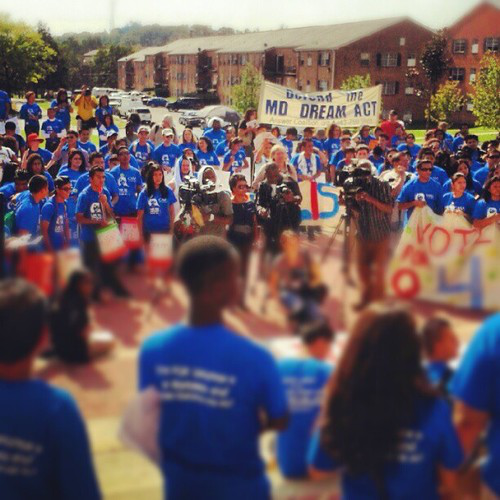 |
| Harvard University Campus |
The
Illegality, Youth, and Belonging Conference that happened in
Harvard Graduate School of Education, October 25-26, 2013, in which over 100
scholars, community advocates, and college students attended, addressed many of
the concepts we are addressing in our study.
Concepts like young adults’ sense of belonging, psychosocial needs, and the
impact of immigration policies on the family structure were discussed. The most exciting aspect of the conference
was meeting some of the leading authors of the field of immigration history,
illegality, and community activism that have and will continue to move the comprehensive
immigration reform forward. Some of the research that was presented claimed
that Mexican-origin young adults (ages 20-25) identified as their primary sense
of belonging in his/her legal status, and not necessarily feeling a sense of
belonging through educational, economic, social, or political participation in
community. These secondary was of
feeling a sense of belonging are then used to claim legal citizenship (Enriquez).
Additionally, leading
scholar Abrego and researchers Del Real, claimed that immigrant youth are
experiencing psychological stressors, like guilt, anxiety, and constant fear,
due to their lack of citizenship status or because they belong to a
mixed-status family. Abrego further
stated that U.S.
citizens in mixed families feel the effect of the unintended consequences of
family members who are undocumented as well, and as a result illegality affects
the entire family structure. Del Real, found that college students’
perpetuation and accumulation of acute and chronic stigma create stressful
experiences. In her study she did find that students exhibited resilient coping
mechanisms, and institutional agents, like college educators and staff, were
able to provide information about scholarships and other resources.
 |
| Harvard University Campus |
Well-known scholars, like
Leo Chavez and Robert Smith, were able to frame the discussion of the current
rhetoric of immigration reform, as well as discuss the influence of this policy
on the motivation of young adults from aspiring to attend higher education. Smith’s
longitudinal study of now full adults, over 30 years old, found that these
individuals were not interested in pursuing college even though they may be
able to because of the current DACA program. These adults feel defeated, and
some cannot afford college due to other life circumstances that were related to
their previous undocumented status.
We look forward to the
publication of all of these scholars’ research in the coming year, and hope that this research will inform and add to our study.
Presentations sources at the
Illegality, Youth, and Belonging Harvard
University Conference, October 25-26, 2013.
Abrego, Leisy J., University
of California-Los Angeles. “Out of Place and Disengaged: Illegality's
Consequences on Citizens in El Salvador and the United States.”
Chavez, Leo R., University
of California-Irvine. “The Legacy of Illegality: Living Outside/Inside the Law
and the Children of Immigrants in the Greater Los Angeles Area.”
Del Real, Deisy, University
of California-Los Angeles. “They See Us Like Trash” The Impact of
Anti-immigrant Stigma Stress on the Psychological Well-being of Unauthorized
Mexican Young Adults.”
Enriquez, Laura E. University
of California-Los Angeles. “I Fit In
[But] I Don’t Know If I Belong”: Undocumented Mexican-Origin Young Adults Navigating
Belonging and Citizenship in the U.S."
Smith, Robert C. Baruch
College and the Graduate Center-City University of New York, “Natural
Experiments in American Immigration: Undocumented and Documented Children of
Immigrants Long Term Mobility.”







.jpg)


